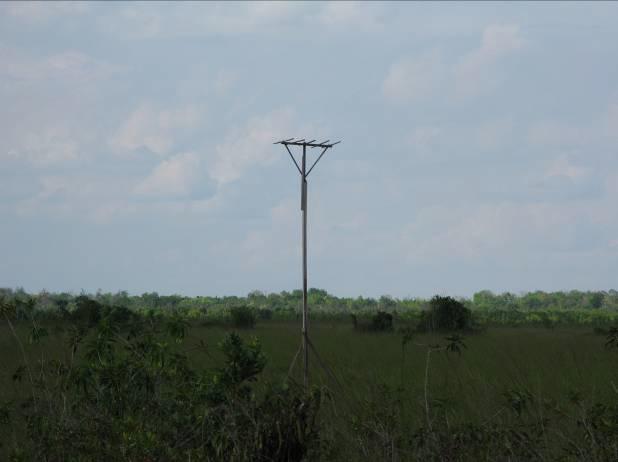Laura Graham
Other projects
This project will construct artificial bird perches in a deforested area to assess their potential to increase seed dispersal and seedling establishment. The results will be combined with other studies to develop a restoration action plan for the area.

Bird observation position.
After deforestation in tropical ecosystems soil quality quickly reduces and the land is abandoned. As the soil becomes degraded, the regeneration capabilities of the ecosystem are also greatly reduced. Studies in restoration ecology in Central America (e.g Zanini and Garade, 2005, Hooper et al., 2005) have begun to elucidate the key ecological factors (or regeneration barriers) that have altered, preventing natural secondary succession from occurring. Main barriers include limited seed dispersal, competition from herbaceous vegetation and fire. One of the most important barriers has been identified as limited seed dispersal. It is thought that 50 – 90% of tropical tree species rely on animal dispersers (Hull, 1998) with birds being the most dominant dispersers in tropical forests.

Constructed artificial bird perch, 200m from the forest edge.
Work in both temperate regions and the neo-tropics has shown that through construction of artificial bird perches in deforested areas, seed rain below perches can be up to 150 times greater than areas without perches (Hooper, 2005). Due to this increase in seed abundance, seedling establishment beneath the bird perches is significantly higher than places without (Zanini and Gerade, 2005). Thus, through their construction, one of the regeneration barriers can be alleviated.
In Central Kalimantan, vast areas of tropical peat swamp forest (TPSF) have been lost, through logging and fires. At the study site, the Natural Laboratory of Peat Swamp Forest, adjacent to the forest, there is an area of riverine forest that was deforested in the 1970s. Since then the forest has been unable to regenerate and has degraded to sedge swamp.
This project will construct artificial bird perches in the deforested area to assess their potential to increase seed dispersal and seedling establishment. Twenty bird perches will be constructed, 100m and 200m from the forest edge. Seeds traps will be placed below these perches and in adjacent control sites. Seed rain and seedling establishment below the perches will be monitored monthly. Dawn and dusk observations on the bird perches, for one week every month, will show bird species and abundance. The results from this will be combined with other studies to develop a restoration action plan for the area. This project has the potential to highlight a key remedial method of restoration in TPSF. As such, the results will not only be of academic interest, but will also serve as a guide for future restoration projects within TPSF, both locally and nationally.